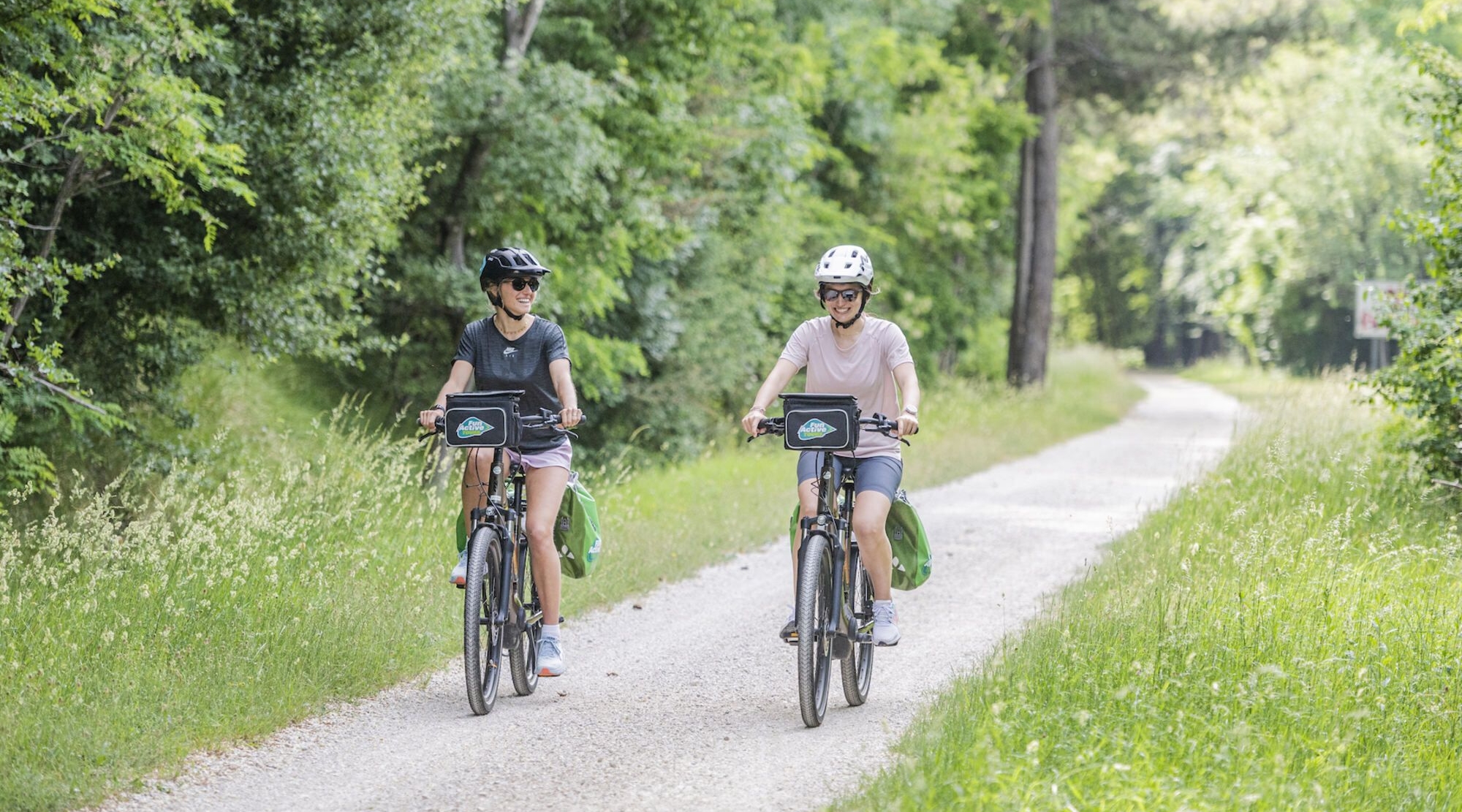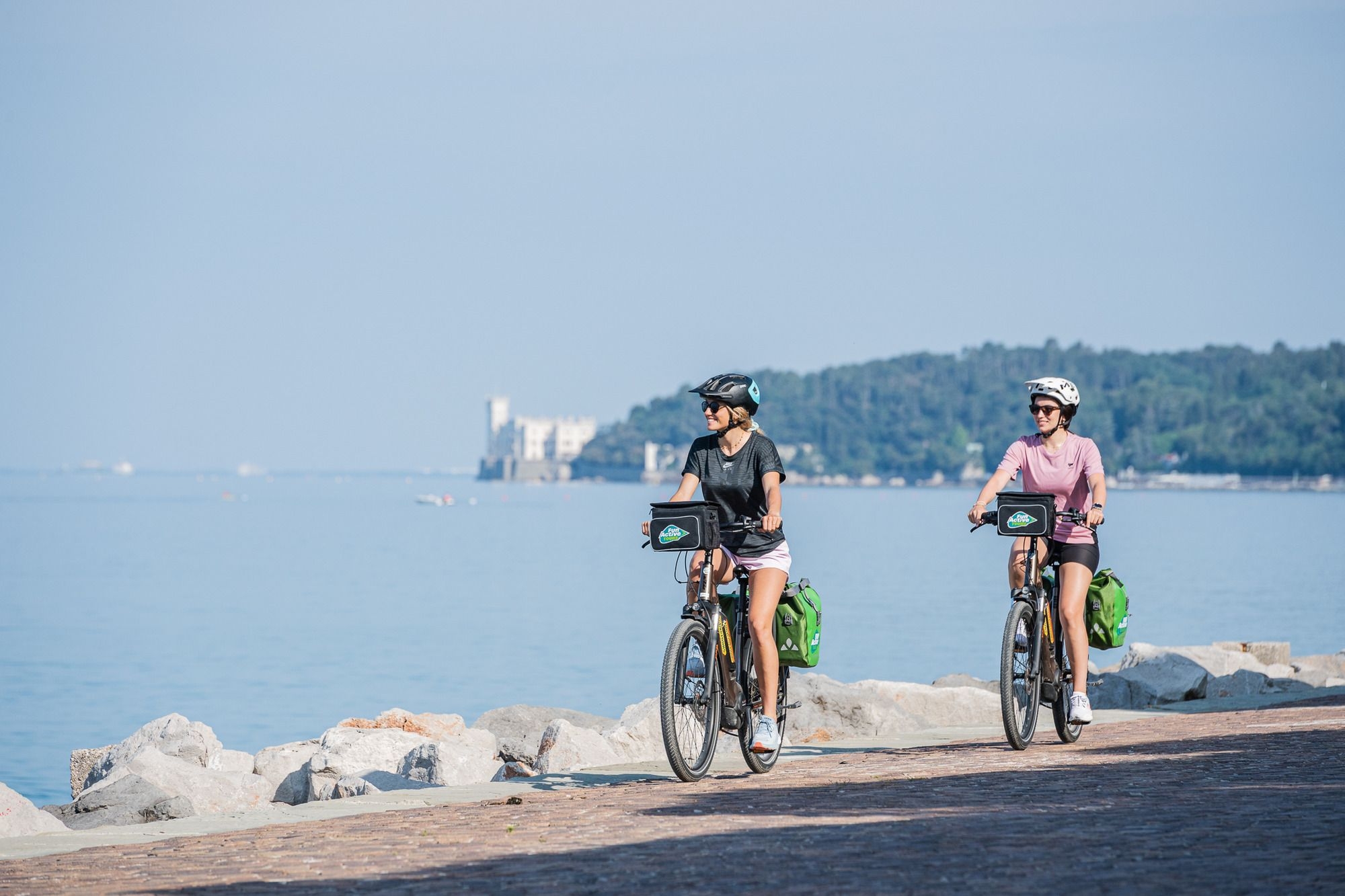8 days
From US $1,295
Self-guided Trieste to Pula Bike Tour
Take on a scenic cycling journey along the Adriatic coast, where each pedal stroke takes you through vibrant cultures, historic towns, and breathtaking seaside landscapes.
This unforgettable adventure from Trieste to Pula weaves through Italy, Slovenia, and Croatia, offering a rich blend of Mediterranean charm and cultural discovery.
Starting in Trieste, you’ll ride along the Slovenian Riviera, past picturesque ports like Izola and Piran, then enter Croatia’s Istrian Peninsula, a land of rolling hills, Roman ruins, and stunning coastlines.
Explore the charming towns of Umag, Novigrad, and Poreč, with highlights such as the UNESCO-listed Euphrasian Basilica and the scenic Limski Fjord. Along the way, you can choose to relax by the sea or venture out on optional boat excursions to the Brijuni Islands.
Your journey ends in Pula, home to one of the best-preserved Roman amphitheatres in the world. Perfect for leisure cyclists and culture lovers alike, this tour is a delightful blend of outdoor activity, seaside relaxation, and timeless history.
Trieste
Pula
casual
easy to moderate
42km / 26mi
6
Ronchi dei Legionari Airport Trieste (TRS)
Pula International Airport (PUY)
Min. 2, Max. 10
Highlights
Itinerary
Brief Itinerary
| Day | Place | casual Inns (subject to availability) | Meals | Distance | Activity |
|---|---|---|---|---|---|
| DAY 1 | Trieste | Hotel Coppe (4-star) | B | ||
| DAY 2 | Piran/Portorôz | Hotel Piran (4-star) | B | 35-65km / 21-40mi | cycling |
| DAY 3 | Umag/Novigrad | Hotel Cittar | B | 35-60km / 21-37mi | cycling |
| DAY 4 | Poreč | BO Palazzo (4-star) | B | 20-40km / 12-24mi | cycling |
| DAY 5 | Poreč | BO Palazzo (4-star) | B | 35km / 21mi | cycling |
| DAY 6 | Rovinj | Villa Marea (4-star) | B | 55km / 34mi | cycling |
| DAY 7 | Pula | Hotel Park Plaza Arena | B | 45-55km / 27-24mi | cycling |
| DAY 8 | Departure | B |
Detailed Itinerary
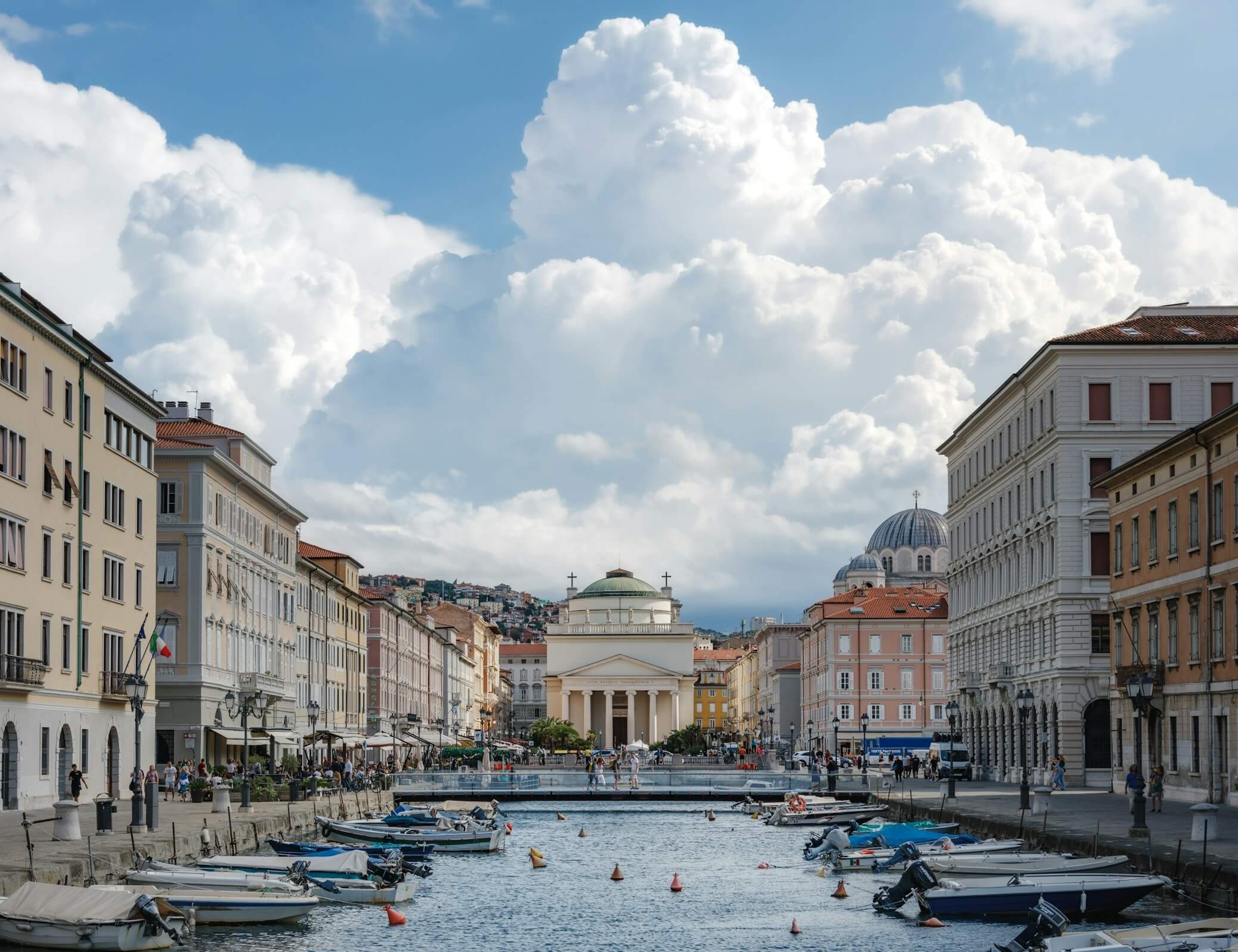
Day 1: Trieste
Welcome to Trieste!
Nestled on the Adriatic Sea near the Slovenian border, this charming Italian city is the perfect starting point for your adventure.
Once a major port of the Austro-Hungarian Empire, Trieste offers a unique mix of cultures, with elegant architecture, buzzing cafés, and a rich literary past. Depending on your arrival time, take a stroll along the waterfront, visit the historic Piazza Unità d’Italia, or climb to Castello di San Giusto for panoramic views of the city and sea.
Our local representatives will deliver your bikes at your hotel.
Settle into your hotel and get ready to begin your coastal cycling journey through Italy, Slovenia, and Croatia.

Day 2: Piran/Portorôz
Today, you cycle along the glittering Adriatic coast as you leave Italy and enter Slovenia.
Ride through seaside gems like Koper and Izola, before arriving in the spa town of Portorož or the charming old town of Piran, depending on where you choose the end the ride.
For a shorter route, hop on a boat to Muggia (ticket not included); the longer scenic version winds through the rugged Val Rosandra.

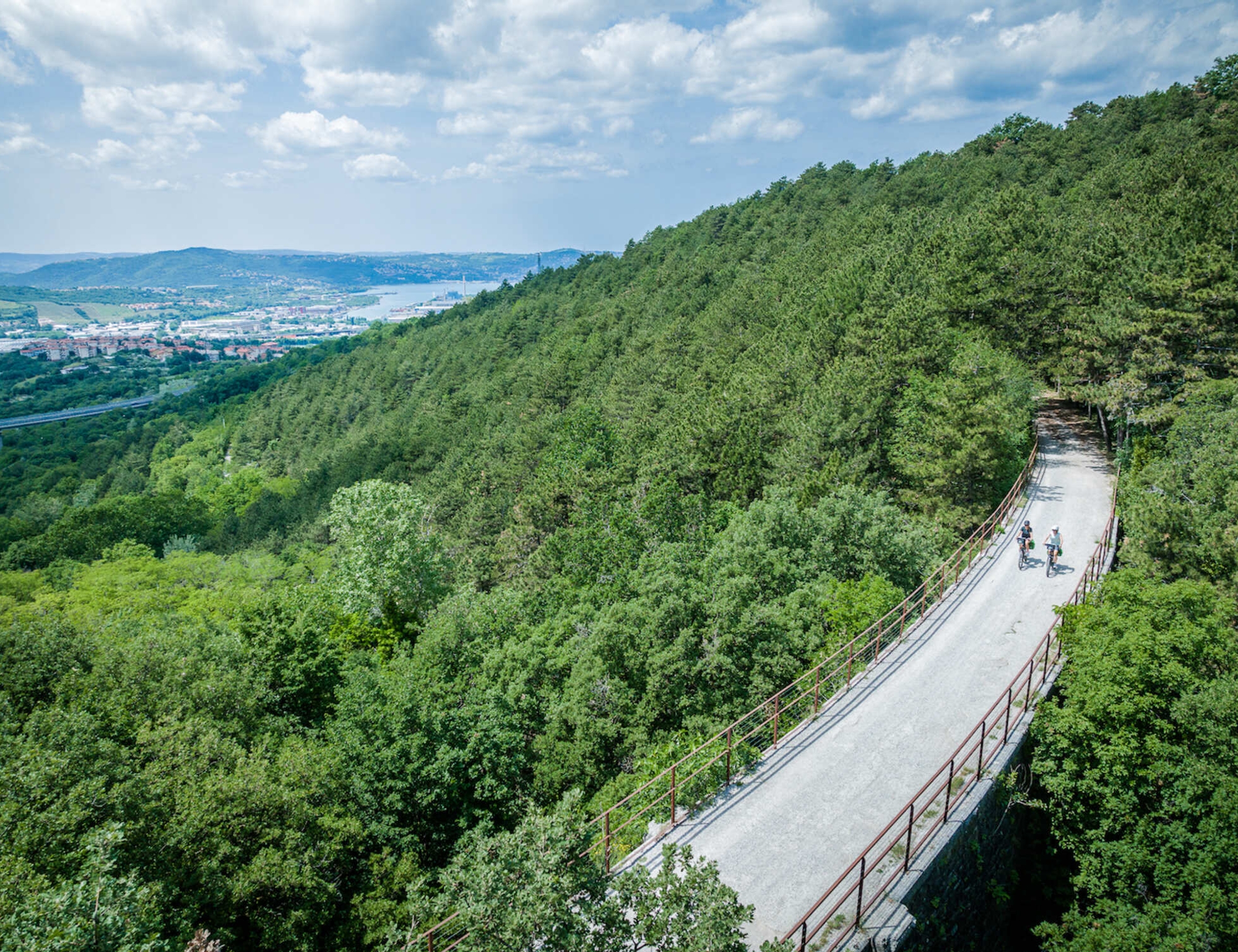
Day 3: Umag/Novigrad
Today you ride past the salt pans of Sečovlje, where sea salt has been harvested for centuries using traditional methods.
Crossing the border into Croatia, you’ll pedal through rolling hills and fertile vineyards as you enter Istria—Croatia’s largest and sunniest peninsula. Continue to Umag, a coastal town rich in Roman history, known for its lively marina and international tennis tournament, the Croatia Open.
Wander through its old town, where narrow cobbled streets meet the sea. Depending on the route, you may continue to Novigrad, a quaint fishing village with ancient walls and a beautiful seaside promenade.

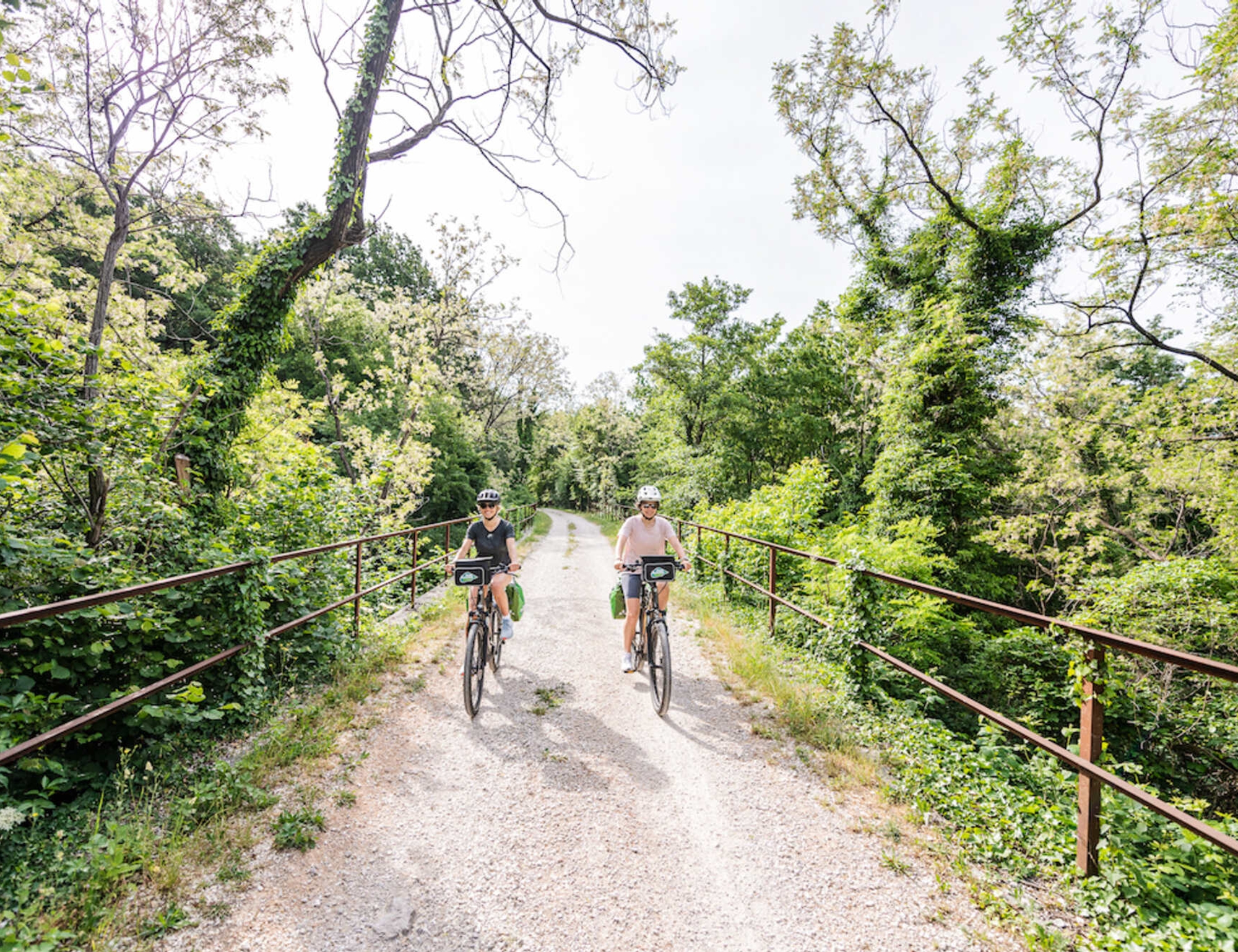
Day 4: Poreč
Today's ride is comparatively short which allows you to fully enjoy the Istrian countryside and coast.
Leaving Umag or Novigrad, you follow a gentle, rolling route toward the town of Poreč. Along the way, take time to appreciate the region's unique blend of rural charm and coastal beauty.
Arriving in Poreč, you’ll discover one of Istria’s most popular destinations. The town is famous for its Euphrasian Basilica, a UNESCO World Heritage site featuring stunning mosaics from the 6th century.
In the evening, wander the lively streets, relax at a waterfront café, and soak in the Adriatic atmosphere.

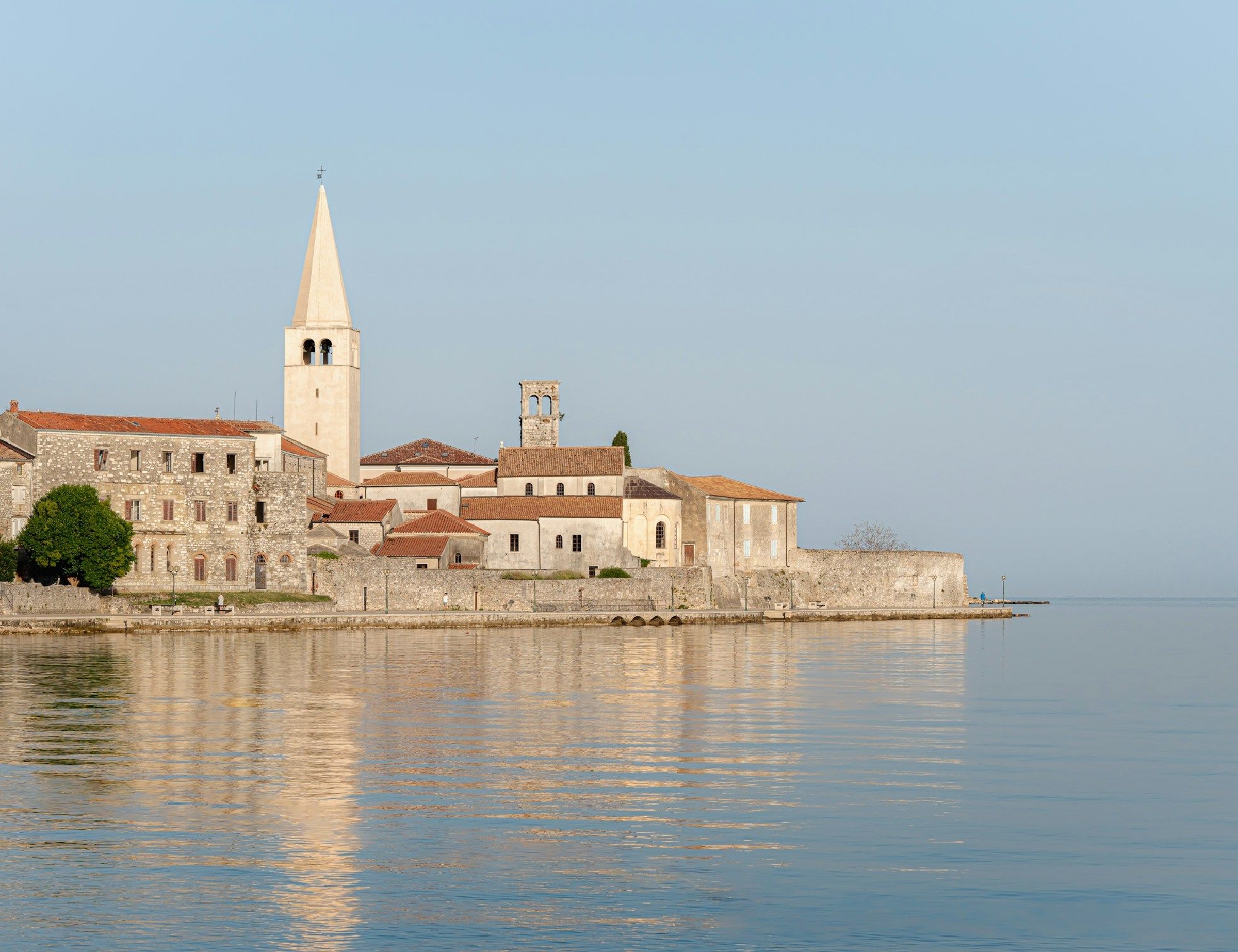
Day 5: Poreč
Today is yours to enjoy as you wish. You can choose to relax or to go cycling.
Spend the day relaxing by the sea, or choose from several memorable excursions.
Take a boat trip to the Brijuni Islands, a protected national park once home to President Tito’s summer residence, where ancient Roman ruins and lush landscapes await.
Alternatively, explore the Limski Channel by boat—a dramatic fjord-like bay where you might spot dolphins and visit oyster farms along the rocky coast.
If you prefer to keep pedaling, opt for a countryside ride through the quiet inland villages and rolling hills surrounding Poreč.


Day 6: Rovinj
Today’s ride leads you further down the Istrian coast to the enchanting town of Rovinj.
Pedal through pine-scented forests and past olive groves and vineyards as the sparkling Adriatic accompanies you.
As you approach Rovinj, its skyline is dominated by the tall bell tower of St. Euphemia’s Church, perched on a hill in the heart of the old town.
Wander the cobbled lanes, browse local art galleries, or take a detour to Zlatni Rt (Golden Cape), a forested peninsula perfect for a sunset swim. Rovinj is often called the most romantic town in Croatia—for good reason.

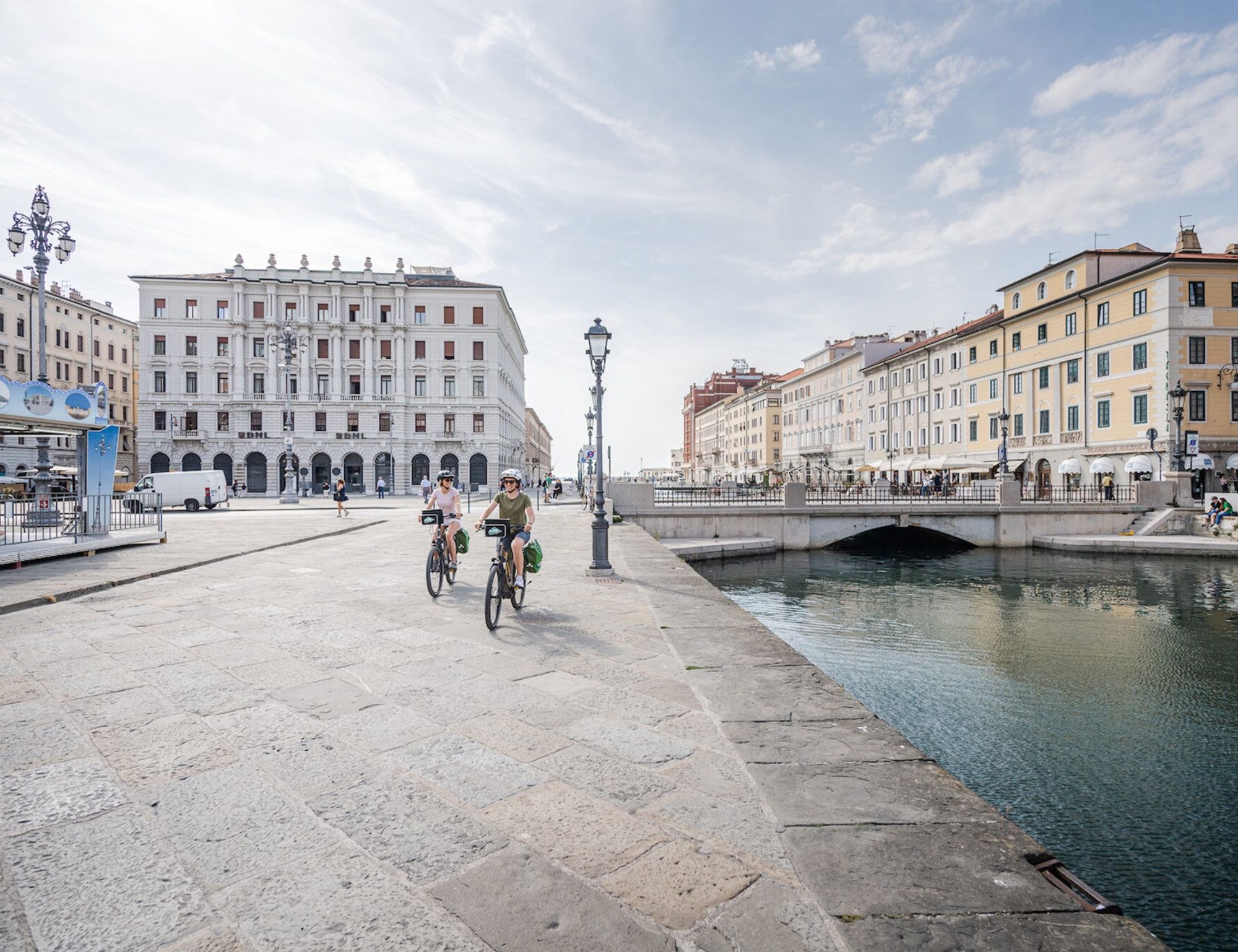
Day 7: Pula
Today is the final full day of cycling which takes you from Rovinj to Pula, at the southern tip of the Istrian Peninsula.
The ride weaves through scenic villages, vineyards, and coastal landscapes before reaching this vibrant city.
Pula is home to one of the best-preserved Roman amphitheaters in the world, which still hosts concerts and events today.
Take time to explore its historic center, filled with ancient ruins, charming squares, and lively markets.
Celebrate the end of your journey with a delicious Istrian meal and raise a glass to the week’s unforgettable adventure.


Day 8: Departure
After breakfast, your cycling tour officially comes to an end.
Depending on your schedule, you can take some extra time to explore Pula, relax on the beach, or extend your stay in this fascinating region.
Transfers or onward travel can be arranged as needed. Farewell, Istria!
Ready to plan your adventure? Download a print-ready detailed itinerary.
Dates and Prices
Single Supplement
From US $300
E-Bike Upgrade
From US $230
Couldn't find a trip with convenient dates?
Open your date as a join-in tour or customize further as a private one.
Essential Info
Inclusions
LODGING
All hotels as mentioned in the tour details or similar (subject to availability).
bike
Immaculately maintained bike with helmet, suited to a terrain.
Luggage Transfer
Transportation of luggage from one hotel to another.
meals
Meals as per itinerary. Guests are given the opportunity to dine on their own so that they discover a location independently.
Exclusions
Airport pickup and drop
We recommend to book direclty from airport or hotel.
Beverages
Beverages such as alcohol, tea, coffee, juice at a hotel or restaurant.
Gratuity
Gratuities for your guide team are not included in the trip price.
Bikes
When you have a road and the thrill of a journey ahead of you, it’s imperative to have a good bike to enjoy it. Our fleet majorly consist of the below bikes as a part of this tour. However, sometimes due to height or availability constraints, we may provide a different but similar quality bike.
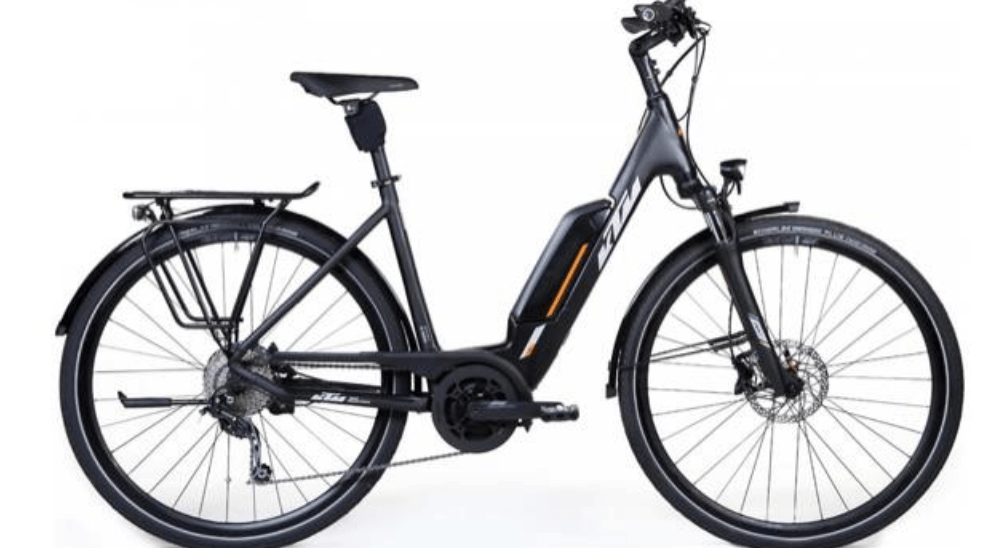
KTM MACINA FUN 510 or similar
Included in your trip price
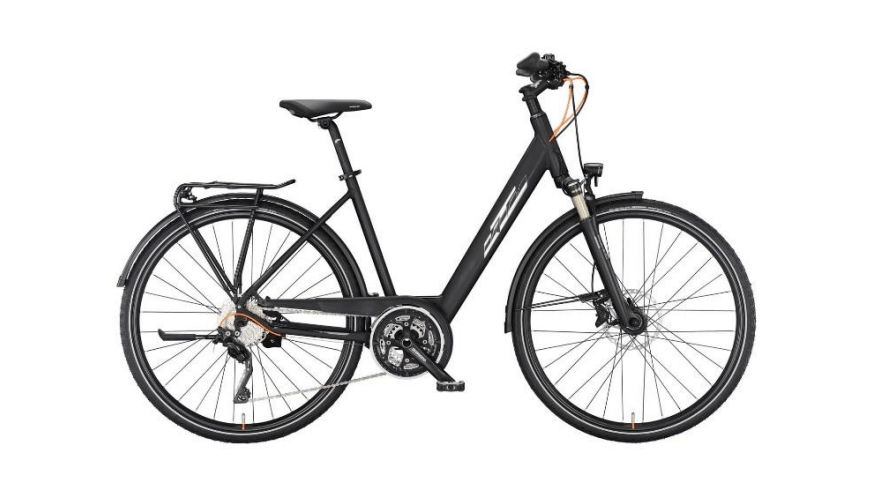
TOP UNISEX or similar
Included in your trip price
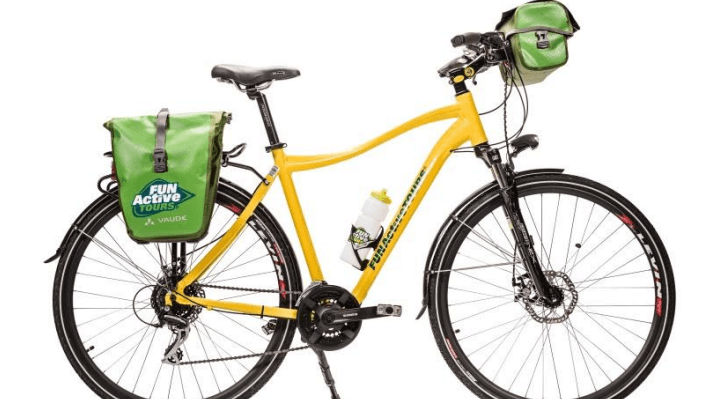
Trekking Rader or similar
Included in your trip price
Weather
The cycling season from Trieste to Pula typically begins in March, with improving conditions by April. May, June, and September offer the best weather—mild temperatures, sunny days, and ideal riding conditions.
July is generally good but can be hot and busy. August is considered off-season due to heat and crowds.
October and November remain pleasant for cycling, while December through February are off-season months with cooler, less predictable weather.
January
Offseason
February
Offseason
March
Mixed
April
Good
May
Best
June
Best
July
Good
August
Offseason
September
Best
October
Good
November
Good
December
Offseason
Best
Good
Mixed
Offseason
What to Pack
Packing smart is essential for a safe and enjoyable cycling adventure. From essential biking gear to clothing and travel necessities, this guide ensures you're prepared for any terrain or climate.
Recommended Bicycling Clothes & Gear
- Bicycling shoes or stiff-soled sneakers.
- Padded cycling shorts.
- Short-fingered cycling gloves (personal gloves are ideal).
- Brightly colored cycling jerseys or synthetic T-shirts for visibility.
- Synthetic cycling socks.
- Sunglasses with UV protection.
- Personal helmet (recommended even though provided).
- Personal saddle (optional for added comfort).
- Rain jacket or windbreaker.
- Cycling water bottle (to reduce plastic waste).
Note: Helmets, gloves, and water bottles are personal items, so bringing your own is recommended for maximum comfort and hygiene.
Clothing
- Light, breathable fabrics like cotton or linen.
- Full-sleeved clothing for sun protection.
- Warm layers for chilly mornings and evenings (if traveling in winter).
- Comfortable footwear for non-cycling time.
- Bring a compact rain jacket in case of sudden weather changes.
- Ethnic or modest clothing for exploring towns and temples.
Other Necessities
- Toiletries: Basic hygiene essentials, including insect/mosquito repellent and sunscreen.
- Hand sanitizer and wet wipes.
- Plug socket adaptor.
- Binoculars for wildlife spotting or desert landscapes.
Pro Tips
- Pack light but plan for the varying temperatures: warm days, chilly evenings, and desert winds.
- Use brightly colored clothing for visibility on roads.
- Pack light to leave room for shopping.
Luggage
Please limit your luggage to one medium-sized suitcase and one carry-on bag. Mark your luggage with your name, address, and phone number.
Visa Information
Before venturing on your adventure, make sure you're equipped with essential travel advice, including security updates, local laws, and crucial passport and visa information. Start by visiting the official government website of your home country for accurate and reliable guidance:
- UK Residents: Stay informed by reviewing the Foreign, Commonwealth & Development Office (FCDO) Travel Advice.
- US Residents: Access vital travel tips and updates through the US Department of State Travel Advice.
- Australian Residents: Plan ahead with the latest updates on the Smart Traveller website.
- Canadian Residents: Find comprehensive travel and visa guidance on the Government of Canada's Travel Advice and Advisories.
- New Zealand Residents: Get practical travel advice on the New Zealand SafeTravel website
- Residents of Other Countries: Check with your government or local consulate for tailored travel advice and requirements.
Note: Passport and visa regulations can change at any time. Stay proactive by checking for the latest updates to ensure a smooth and stress-free journey.
Insurance
Medical insurance that covers medical costs in case of an accident during the trip is mandatory to participate in our tours.
We recommend to purchase adequate travel insurance in order to participate in our tours and protect yourself from unforeseen events. Our experience shows that guests who purchase travel insurance—including coverage for all activities on the itinerary, trip cancellation, interruption, delay, baggage damage, loss or theft, personal accident, death and repatriation costs, medical and emergency expenses (including Covid-19), and personal liability—travel with greater peace of mind.
Can I use my credit card insurance?
Yes, as long as it meets our requirements and provides adequate coverage. Ensure you have an emergency contact number and policy number available.
When should I buy travel insurance?
Purchase travel insurance as soon as you've paid in full or booked your flights.
Is proof of travel insurance required?
Yes. You must provide your insurer's name, policy number, and emergency contact via our reservation form. This is mandatory. If you cannot provide proof, you’ll need to purchase insurance before traveling with us.
Does Art of Bicycle Trips sell travel insurance?
We do not sell travel insurance directly, as we believe our customers should have the freedom to choose a policy that best suits their needs. However, we recommend Insured Nomads as a great starting point.
Frequently Asked Questions
We provide an app-based navigation system that can also be used offline. You can download the app to your phone in advance, and we will share the login details ahead of your trip. Since the app works offline, it helps conserve your phone's battery during use.
For minor issues like punctures, the guests are provided with a self-repair kit, which includes tire levers, a spare tube, a patch kit, and a pump, allowing riders to fix the problem themselves. Self-guided riders are expected to be independent in handling these minor problems. While there are some bike shops along the route, they are limited. If you are unsure about how to repair a puncture, we recommend considering a guided or van-supported trip instead.
For major mechanical failures, such as a cable break, the guests can contact the emergency support number provided. The support team will help coordinate a solution, which could include dispatching a local mechanic, suggesting a nearby bicycle shop for repairs, or sending a vehicle to pick up the rider. Please note that all support services will be provided on a chargeable basis, and assistance may take time, so we advise being prepared for potential delays.
We provide 24/7 emergency support by phone for any medical emergencies during the tour. Our team will assist in coordinating medical care, guiding you to the nearest healthcare facility, and ensuring you receive the necessary support. The national emergency system is reliable and effective, and in the event of a serious accident, contacting them is highly recommended. However, due to our distance from certain areas, response times may be longer. We strongly recommend having appropriate travel insurance, and we will do everything we can to ensure your safety and well-being during an emergency.
The fitness level required for each trip is indicated by the "level" of the tour, which in turn is mentioned on each tour page right next to the price and the trip duration.
Easy: The terrain is mostly flat with a few gentle climbs.
Moderate: The terrain is either mostly flat or consists of rolling hills with a few challenging climbs. There could also be a few days with longer riding distances of up to 75 kms (45 miles)
Difficult: The terrain is mostly hilly with strong elevation gains and/or has long days on the bike. Such trips are recommended for intermediate to advanced cyclists.
Please note that we usually bike around 4-5 hours per day irrespective of the level of the trip.
You can exchange currency at the airport itself, or at ATMs in larger cities. Most commercial establishments will accept international credit cards for payments, though its good to carry some local currency with you at all times.
The meeting time on Day 1 is mentioned in your travel planner shared with you. You can arrive either on the morning of Day 1 depending on the meeting time, or book a pre-tour night to arrive a day earlier.
For answers to broader questions, please visit our Comprehensive FAQs section.

